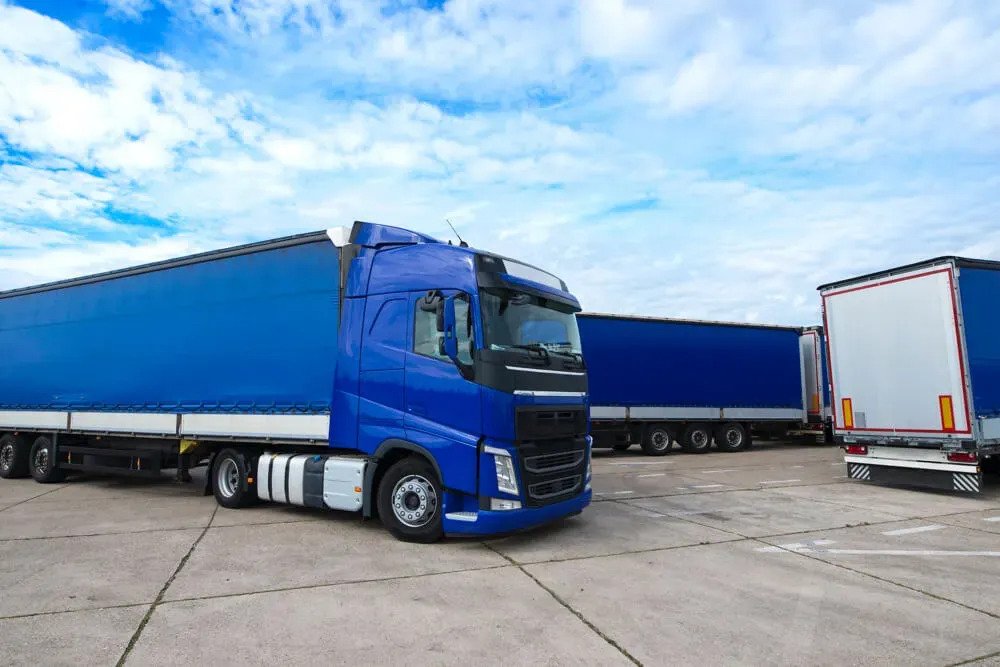Warehouse loading docks are a gateway that essentially all production must go through. If something goes wrong at the gateway, it puts an entire supply chain on hold. One of the most common pitfalls is loading dock congestion that goes hand in hand with truck detention.
If trucks are constantly queuing at your warehouse, it puts pressure on your warehouse staff, delays carriers and doesn’t make any driver’s life easier. Loading bays, which are designated areas for loading and unloading goods, play a crucial role here—their configuration, whether exterior or enclosed, and the supporting infrastructure can significantly impact congestion levels. In the end, a lot of resources are wasted and nobody wins.
In this post, we will explore the congested loading docks problem - why it happens, what effects it has and how to prevent it with a Dock scheduling system.
Congestion at Loading Docks – Why does It Happen?
Congestion at loading docks is a widespread challenge that often arises when the volume of vehicles, freight, and deliveries surpasses the capacity of the dock area. This bottleneck can be triggered by several factors, including outdated or inadequate dock equipment that slows down the loading and unloading process, or limited access points that restrict the smooth flow of vehicles in and out of the docks. Poorly scheduled load and unload times can also result in multiple vehicles arriving simultaneously, overwhelming the available dock space and staff.
Inefficient use of the dock area, such as failing to maximize available bays or not designating specific service areas for different types of deliveries, can further exacerbate congestion. Without proper traffic management, vehicles may block each other, causing unnecessary delays and increasing the risk of accidents. Additionally, spikes in demand—whether due to seasonal events, special promotions, or increased media coverage—can put extra pressure on loading docks, leading to longer wait times and reduced efficiency.
To keep operations running smoothly, it’s essential to identify these root causes and implement targeted solutions. By optimizing the use of loading docks, upgrading dock equipment, and improving access and scheduling, facilities can minimize congestion, enhance safety, and ensure timely service for all deliveries and events.

Some facilities use the first-come-first-served policy which by its nature creates loading dock congestions with truck queues at prime time and an empty yard at less convenient hours. This operating model is usually determined by the nature of the business, shipped production and truck congestion are considered normal and acceptable.
Not all pickup and delivery locations are newly built, spacious and well-thought facilities. Some warehouse loading docks are just difficult to get to since the surrounding environment is full of narrow passages and various obstacles along the way. If the extra time to get the truck to the loading dock and out of the yard is not taken into account, it will create delays for all other deliveries.
Recent research on truck landside congestions gives a broader and more scientific point of view to the causes for congested loading docks. Research published in 2021, Why are we still queuing? Exploring landside congestion factors in Australian bulk cargo port terminal, identified 7 factors that contribute to the landside truck congestion: infrastructure limitation, the interdependence of operations, operational disruptions, limited coordination, incentive misalignment, supply chain flexibility, performance expectations. Even though this research was done in the context of a bulk port terminal, its findings are also relevant to larger shipping facilities and warehouses.
Planning your dock processes manually is inefficient and nerve-wrecking. Learn more about it in our blog "The Cost of Manual Dock Scheduling".
Congestion at Loading Docks and Loading Dock Equipment - Why does It Happen?
So, why do the loading docks get clogged and become a bottleneck? Lack of planning, heavy traffic, bad weather conditions and many other factors could cause trucks to arrive not when they were expected, form truck queues and create congestion at the yard. Still, when talking to the logistics and warehouse management experts, a few common reasons are often highlighted.
Poor warehouse dock schedule organization is one of the most frequent root causes for truck congestion at the warehouse. Many facilities still rely on manual dock scheduling processes – making phone calls, sending emails, creating schedules in excel sheets, whiteboards or paper documents. Staff often maintain a list of scheduled trucks or required parts, which can be cumbersome and error-prone. Manual dock scheduling is slow, prone to human errors and requires a lot of effort. At some point, it is destined to fail whether because someone missed a call, overbooked a dock or the high volume of shipments overwhelmed staff and caused warehouse operations to break down. Keeping dock operations in order becomes a significant challenge when relying on these outdated methods.
Warehouse prepared for loading
Some facilities use the first-come-first-served policy which by its nature creates loading dock congestions with truck queues at prime time and an empty yard at less convenient hours. This operating model is usually determined by the nature of the business, shipped production and truck congestion are considered normal and acceptable.
Not all pickup and delivery locations are newly built, spacious and well-thought facilities. Some warehouse loading docks are just difficult to get to since the surrounding environment is full of narrow passages and various obstacles along the way. If the extra time to get the truck to the loading dock and out of the yard is not taken into account, it will create delays for all other deliveries.
Recent research on truck landside congestions gives a broader and more scientific point of view to the causes for congested loading docks. Research published in 2021, Why are we still queuing? Exploring landside congestion factors in Australian bulk cargo port terminal, identified 7 factors that contribute to the landside truck congestion: infrastructure limitation, the interdependence of operations, operational disruptions, limited coordination, incentive misalignment, supply chain flexibility, performance expectations. Even though this research was done in the context of a bulk port terminal, its findings are also relevant to larger shipping facilities and warehouses.
Planning your dock processes manually is inefficient and nerve-wrecking. Learn more about it in our blog “The Cost of Manual Dock Scheduling“.
What is Truck Detention?
Congested warehouse loading docks have a direct impact on another huge issue in the industry - truck detention. Truck detention is probably one of the most irritating and aggravating parts of a drivers’ job. Unfortunately, it is also very common and unavoidable.

When a driver arrives at a pickup or delivery location, there is a dedicated time window for loading and unloading the truck. This time window is considered to be long enough for a truck to be fully loaded or unloaded. A widely accepted rule of thumb is that two hours is a reasonable amount of time to fully load or unload the trailer. Meaning that anything over a two-hour wait is considered a detention time.
What are the Effects of Truck Detention?
Every hour of truck detention comes with a price. Theoretically, if the driver is detained at the receiver’s facility, he is entitled to ask for detention pay. In the U.S. it ranges from $25 to $100 for every hour that truck spent in detention. Of course, it all depends on the contract between the shipper and receiver, but detention pay is a standard practice in the industry. However, many smaller carrier companies, that comprise most of the industry, don’t ask for detention pay to maintain good relationships with their customers.
Nevertheless, drivers are the ones that feel the real cost of detention. The extra hours spent at customers' facilities put drivers behind their schedule and can make them late for other stops on their route. It also wastes drivers available hours of service which are strictly regulated in the U.S. and EU. While waiting at customers' facilities, drivers are often denied access to a restroom, not allowed to leave their truck, sleep or remain at a customer facility if they run out of available hours of service. Inevitably everything adds up to a lot of stress, pressure and fatigue.

2018 study by the U.S. Department of Transportation estimated that a 15-minute increase in average dwell time – the total time spent by a truck at facility loading or unloading plus the detention time – increases the average expected crash rate by 6.2 percent.
How Big of an Issue is It?
Delays at customer facilities are one of the most common issues in the transportation industry. In fact, this problem is so painful that in the American Transportation Research Insitute’s (ATRI) annual report on the trucking industry, it ranked among the Top 10 biggest issues. Even more, detention times that were caused by loading dock congestion made it to the Top 10 three years in a row (2021 - 7th, 2020 - 9th, 2019 - 4th). Naturally, the global driver shortage and COVID-19 pandemic related challenges are at the forefront of industry conversation, but delays at customer facilities are also a widely discussed topic.
According to a 2018 study by the U.S. Department of Transportation, loading dock wait times cost truckers an estimated $1.1 billion to $1.3 billion in income annually. Yes, that’s right - over $1 billion every year.
Planning your docks efficiently is a big responsibility. Find more tips in our blog "Checklist: are You Planning Your Docks Smartly".

Broader Solutions and Optimization Strategies
Tackling congestion at loading docks requires a comprehensive approach that goes beyond basic scheduling. Investing in advanced dock equipment—such as automated dock levelers, vehicle restraint systems, and modern safety barriers—can significantly improve both efficiency and safety during loading and unloading. These upgrades help ensure that vehicles and freight move smoothly through the dock, reducing bottlenecks and minimizing the risk of accidents.
Optimizing dock scheduling and access is another key strategy. By carefully coordinating when vehicles arrive and depart, and by designating specific docks or service areas for different types of loads, facilities can make the most of their available space and resources. This not only reduces congestion but also helps prevent delays that can ripple through the entire supply chain.
Training is equally important. Providing dock workers and drivers with thorough instruction on safe systems of work and the proper use of dock equipment ensures that everyone knows how to operate efficiently and safely. Well-trained staff are better equipped to handle unexpected challenges and keep the loading docks running smoothly.
Finally, implementing a dock scheduling platform can tie all these strategies together, streamlining the entire process and making it easier to manage access, vehicles, and freight in real time. By adopting a holistic approach to dock management, organizations can transform congested loading docks into efficient, well-organized hubs that support their business goals.
Low Hanging Fruit - Dock Scheduling Platform
One of the easiest solutions for congested loading docks is to start using a modern Dock scheduling platform. Replacing the outdated tools and methods with a Dock scheduling software will organize truck arrivals and departures in no time. No more tedious, time-consuming manual work for your staff and significantly reduced (or even fully eliminated) truck detention times.
To start benefiting from a Dock scheduling platform you do not need any large investments in infrastructure or equipment. All you need is a device with an internet connection and an hour-long training for your staff and carriers. Essentially, it is just a matter of how you organize the dock scheduling process with the right dock scheduling software.
Switching operations to a Dock scheduling platform can be as fast as a few weeks and results can be seen the very next day. Book a quick call with our expert and we will help you to understand how the Dock scheduling platform such as GoRamp could benefit your operation.



